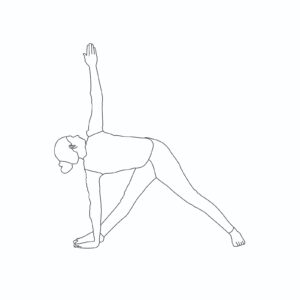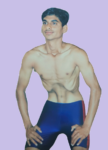Meaning of triangle pose
Triangle pose consists of two Sanskrit words: tri means ‘three’, and the word Kona means ‘angle’. Therefore, it is called Trikonasana or a three-angle pose. But more commonly, it is known as ‘triangle pose’. In the given article, you will know what triangle pose is, how to do it, and its benefits and precautions. All these aspects have been systematically mentioned ahead. The easily explained steps, uses, precautions, images, and videos of triangle pose/trikonasana will help you understand the asana technically, thereby extracting maximum benefits from it.

Trikonasana is among the few yoga poses that give effective twisting, compressing, and stretching to the body, especially the lower abdominal region. Triangle pose is known for weight loss and burning belly fat because of its twisting and stretching nature.
The different names of triangle pose
- Trikonasana
- Utthita Trikonasana
- Extended triangle pose
- Baddha trikonasana (Bound triangle pose)
- Parivrtta trikonasana (Revolved triangle pose)

How to do triangle pose step by step
The technique of doing the steps of triangle pose yoga is very simple and easy. Following the below process, one can even perform the trikonasana in one’s place. The step-by-step process of completing the pose is described here.
- Stand erect on a flat surface.
- Make a distance of 4 feet between the legs.
- Arms should be stretched at the shoulder level.
- Inhale and raise your right arm beside your head.
- Exhale, bring your right arm towards your left hand and ensure to make it parallel to the ground.
- Put your left hand on the left leg without putting any pressure.
- Feel the body weight equally between both legs.
- Do inhaling and exhaling slowly.
- Maintain the pose as long as you feel convenient.
- Do the same with the left arm.
- This is the one round.
- Do three to four rounds.
Breathing
The benefits of a yogic posture increase manifolds if it performs with breathing awareness. Trikonasana is also included. Inhale slowly and deeply while raising your arm upward beside your head. Exhale while bending another side. While maintaining the pose, inhale and exhale slowly. Inhale, come to the original position slowly.
Muscular movement
Muscles have greater importance, especially in extracting benefits while performing the triangle pose. The various body parts, including the abdomen, legs, thighs, arms, etc., experience stretching, twisting, compressing, and relaxing in their muscles, especially with the finer forces.
Instructional video of triangle pose
- The video of Trikonasana has been made very simple and easy to help understand the practitioners.
- It has been developed after a discussion with many yoga experts and teachers.
- Extensive research has also been carried out while making the video.
Video Courtesy: MDNIY
Triangle pose as per different schools of yoga
There are some variations in other schools of yoga while practising trikonasana.
- Iyengar yoga: Here, one hand is kept beside the head upward while another hand will be on the surface behind your bending feet, just crossing the knee, making a straight line.
- Vinyasa Yoga: The pose resembles Iyengar yoga, wherein your palms touch your toes.
- Ashtanga yoga: It is similar to vinyasa yoga.
- Baba Ramdev yoga: One hand is parallel to the ground while another touches the same side leg.
- Art of living: The same procedure is followed as vinyasa yoga.
- Power yoga: Here, stretching, maintaining, and rigour of the posture is essential.
- Bikram yoga: It is just like Parsvkonasana. But, here, the hand is not parallel to the ground. It is upward beside the head.
- Hot yoga: It is similar to power yoga but more strenuous.
- Satyananda yoga: A series of five asanas are performed in sequence.
Top 10 health benefits of triangle pose
The pose is known for many benefits. Some of the essential benefits are being mentioned here.
- Weight loss: This is one of the essential yoga poses, good for burning abdominal fat because of its twisting, compressing, and stretching in nature. It puts adequate stretching in the abdominal region. It is also effective for the person suffering from obesity.
- Backache: It is beneficial in the management of backache. I would suggest doing it in the presence of a yoga teacher to relieve the condition.
- Height increase: It gives adequate stretching to the body, especially the arms, legs, and abdominal region. Practising it regularly helps to increase the height of growing children.
- Waist slimming: This yoga ensures a more significant impact on the waist region, thus suitable for waist slimming.
- Good for legs: It helps to strengthen legs, hips, knees, and ankles because of adequate stretching in these parts of the body. It is also helpful in correcting minor deformities
- Spinal nerves: It benefits the spinal region and associated nerves. It is suitable for the health of the entire nervous system, which tones up the system because of its beneficial impact.
- Muscle health: More or less, all the yoga poses directly or indirectly affect the muscles. But, there are few yoga poses that act upon the powers of the entire body. A triangle pose is one of them.
- Chest expansion: It facilitates adequate stretching to the chest region. Thus, it is good for chest expansion and preventing respiratory-related problems.
- Joint pain: It loosens up the muscles and is good for the joints of the entire body.
- Digestion: The suitable massage of the abdominal organs stimulates the internal muscles and nerves of the digestive system, thus beneficial for digestion and relieving constipation.
Contraindications
Some of the few precautions/limitations of tadasana are:
- Back pain: Don’t practice during acute backache.
- Migraine: Avoid practising in case of migraine.
- High blood pressure: It should be avoided in high blood pressure.
- Dizziness: A person suffering from dizziness shouldn’t be looked down on while practising the yoga pose.
- Cervical spondylosis: Skip it if someone is having this problem
- Knee and neck: In case of knee and neck injuries, do it with care.
Beginner’s tip
To perform the asana technically correctly takes some work for the beginner. However, one can master it with regular practice and following the easy steps of doing this asana. First, I’d like you to do it by keeping one hand up and another parallel to the leg.
Variations
- Extended Triangle pose (Utthitatrikonasana)
- Bound Triangle pose (Baddhatrikonasana)
- Revolved Triangle pose (Parivrttatrikonasana)
- Reclining triangle pose (Suptatrikonasana)

Similar pose to triangle yoga
- Tadasana
- Tree posture (Vrikshasana )
- Warrior pose (Virbhadrasana)
Counter pose
- Tadasana
- Stickasana
The science behind triangle pose
To get the maximum benefits of this yoga pose, one should be aware of the anatomy, physiology, and movement of all the muscles, especially the finer muscles. In the case of trikonasana, the maximum focus is on lateral movement. Spine neutral extension, slight rotation, head axial rotation, upper limb abduction, and external rotation are involved in the asana. In the case of the front leg, hip external rotation, flexion, abduction, knee extension, slight ankle plantar flexion, and small foot pronation are more prominent. At the same time, the back leg experiences hip internal rotation, adduction, extension, knee extension, and foot supination.
Top 10 facts about triangle pose
- This is one of the yoga poses that revitalises the entire body system.
- The asana helps to bring stability, strength, and stamina.
- It has therapeutic relevance by strengthening the core and legs.
- Burning unnecessary fats from the stomach, hips, thighs, waist, and arms can be practised.
- Yoga can be practised at any time, place, or office without formalities.
- It helps speed up blood circulation, thus re-energising the entire body mechanism.
- It is waist-slim yoga.
- It helps to tone up the muscles and nerves of the entire body.
- It can be used for stress management.
- avoid taking any pressure on the knees while performing the asana.






